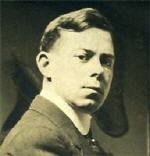
Philip R. Goodwin was a precocious child, painting and drawing from a young age. At age 11, he sold his first illustrated story to
Collier's. He studied at the Rhode Island School of Design, the Art Students League in New York City, the Drexel Institute in Philadelphia, as well as under famed illustrator Howard Pyle at the Howard Pyle School. At the age of 22, in 1903, Goodwin illustrated Jack London's
Call of the Wild and later Theodore Roosevelt's
African Game Trails as well as posters, calendars, and other advertisements. In 1904, he opened a studio in New York, where he created illustrations for
Collier's Weekly,
Everybody's Magazine,
Outdoor Life, and
McClure's Magazine, as well as covers for
The Saturday Evening Post. He was an avid sportsman and outdoorsman and befriended Charles Russell, N.C. Wyeth, Carl Rungius, Theodore Roosevelt, Will Rogers, and Ernest Seton Thompson. Rungius taught Goodwin an appreciation for hunting in order to become closer to wildlife subjects. Traveling on many sketching expeditions together, Goodwin influenced Russell's painting techniques and use of color.
In the National Museum of Wildlife Art's
The Surprise, a photographer is coming upon a mother bear and her two cubs. The painting exemplifies Goodwin's open color palette, use of distance and atmosphere, and sense of humor. He painted many wildlife, hunting, fishing, and western scenes, often composed from behind the subject's shoulder.
Goodwin's work is recognized in many private collections and museums, including the American Museum of Natural History, the Charles M. Russell Museum, the Thomas Gilcrease Institute, the Brandywine River Museum, the National Cowboy Hall of Fame, the Glenbow Museum, the Buffalo Bill Historical Center, and the National Museum of Wildlife Art.